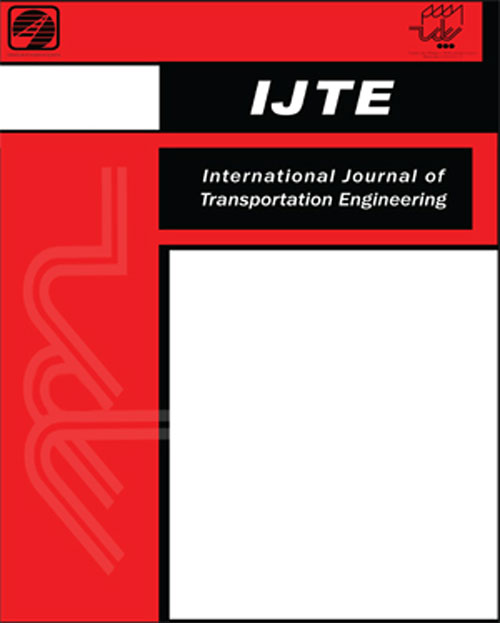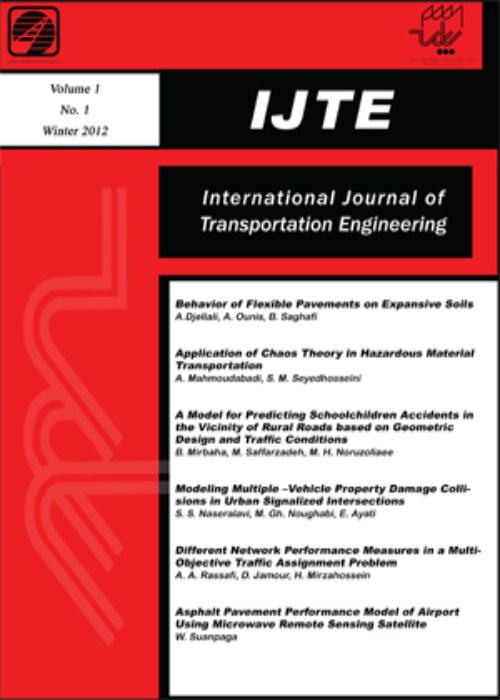فهرست مطالب

International Journal of Transportation Engineering
Volume:2 Issue: 2, Autumn 2014
- تاریخ انتشار: 1393/11/23
- تعداد عناوین: 6
-
-
Pages 97-106In this research, the efficiency of Recycled Glass Powder (RGP) is evaluated for improvement of polymer-modified bitumen and asphalt mixture performance. An extensive laboratory programm was undertaken for polymer-modified bitumen including Crumb Rubber (CR), Styrene Butadiene Styrene (SBS) and Styrene Butadiene Rubber (SBR). Rheological and mechanical properties of modified bitumen samples such as penetration index (PI), and also asphalt mixture performance indices including Marshall stability, indirect tensile strength (ITS), compressive strength and indirect tensile stiffness modulus (ITSM) were investigated. The results showed that application of RGP-CR modifier had not only positive impact on the efficiency of bitumen and asphalt, but also made more improvement in their engineering properties. Moreover, modification using 5% CR and 5% RGP in asphalt mixtures resulted in the best overall performance. Moreover, from environmental point of view, application of RGP in asphalt mixtures is considered to be beneficial since it prevents accumulation of waste glass in the natural environment.Keywords: Crumb rubber, styrene butadiene styrene, styrene butadiene rubber, recycled glass powder, stone matrix asphalt
-
Pages 107-118In this paper, a multi-perspective decision support system (MP-DSS) to design hierarchical public transportation network is developed. Since this problem depends on different perspectives, MP-DSS consists of two sub-systems with macro and micro sub-systems based on travel information, land use and expert knowledge. In the micro sub-system, two sub-modules are developed considering origin-destination demand matrix and attractive places to travel. In the first sub-system, based on traffic assignment models, the bus corridors can be extended and by the second approach, connectivity between attractive places can be provided by new bus lanes. Multi-commodity flow problem and spanning tree problem are used in these two sub-modules to assign the public services to the corresponding networks. The corridors obtained from these sub-modules are evaluated by experts board module. These corridors are used to extend bus rapid transit (BRT), exclusive bus lanes between multiple districts and shuttle buses for trips inside of district. A prototype of MP-DSS is developed to illustrate the results on Tehran network. The most important contribution of this paper is to generalize the different mathematical models with land use and expert knowledge which substantially improves the results of network designing problem.Keywords: Network optimizationý, ýDSSý, ýTraffic assignmentý, simulationý, ýexpert systemý
-
Pages 119-130Herein, the performance of graphene oxide (GO) in improving mechanical properties and subsequently reducing the permeability of cement composites used in concrete pavement, is studied. A polycarboxylate superplasticizer was used to improve the dispersion of GO flakes in the cement. The mechanical strength of graphene-cement nanocomposites containing 0.1–2 wt% GO and 0.5 wt% superplasticizer was measured and compared with that of cement prepared without GO. We found that the tensile strength of the cement mortar increased with GO content, reaching 1.5%, a 48% increase in tensile strength. Ultra high-resolution field emission scanning electron microscopy (FE-SEM) used to observe the fracture surface of samples containing 1.5 wt% GO indicated that the nano GO flakes were well dispersed in the matrix, and no aggregates were observed. FE-SEM observation also revealed good bonding between the GO surfaces and the surrounding cement matrix. In addition, XRD diffraction data showed growth of the calcium silicate hydrates (C-S-H) gels in GO cement mortar compared with the normal cement mortar. Growths of the calcium silicate hydrates (C-S-H) gels causes reduce in permeability and consequently improvement in durability of the cement composite.Keywords: Cement, Nanocomposite, graphene oxide, mechanical properties, tensile strength. Pavement
-
Pages 131-144Passenger information aims at improving the user-friendliness of public transport systems while influencing passenger route choices to satisfy transit user’s travel requirements. The integration of transit information from multiple agencies is a major challenge in implementation of multi-modal passenger information systems. The problem of information sharing is further compounded by the multi-lingual and multi-cultural population of developing countries such as India. Ontology, by explicit specification of conceptualisation, not only addresses the issues pertaining to syntactic interoperability arising due to widely varied system architectures and software used by different agencies, but also ensures semantic interoperability caused by cognitive and naming heterogeneity. This paper develops a domain-specific ontology for public transport systems, which is further integrated with the domain-ontology of urban features with an objective of supporting multi-modal public transport information retrieval. The ontology thus developed is formalised using Web Ontology Language. In order to evaluate the capability of ontology in passenger information retrieval, the proposed ontology is implemented for five regular bus service routes and one bus rapid transit route in Ahmedabad city. The study defines 1336 named individuals (instances of concepts in ontology) including 293 instances of urban features and 1043 instances of public transport features. The capability of ontology in supporting general service information queries, itinerary planning, and multimodal trip planning have also been demonstrated. The study concludes that the domain-specific public transport ontology when integrated with urban features ontology, not only enables sharing of data across multiple transit agencies, but also expands the search space for passenger route choices by sharing the meaning of information.Keywords: Ontology, public transport, passenger information, multimodal transport, semantic interoperability
-
Pages 145-154Transportation models as tools for transportation planning are critical to such related decisions. Considering the high cost of calibrating and validating such models, effective alternatives are highly sought for; one such alternative being the use of models calibrated for other cities. This calls for transferability analysis which has not been the subject of many researches. Due to criticality of aggregate and disaggregate data in transportation models, this paper tries to compare transferability of models calibrated with data of both groups. Mode choice models for daily work trips in two real-sized cities of Qazvin and Shiraz are analyzed. Models are calibrated employing multinomial logit structure with four modes of private car, taxi, bus, and 2-wheelers. In order to increase reliability of results, the top five best models are selected for each city-data category to be transferred. Based on transferability test statistics, transfer index, and goodness-of-fit of transfer models, aggregate models are not transferable and their results are deceptive. Transferability measures of these models are not in acceptable range; whereas transferability of disaggregate models have relative proper response. According to transfer index and goodness-of-fit of origin models operate similar to destination models. However transferability test statistics rejects the assumption of equality coefficients in both cities models. Using personal variables helps to effectively transfer origin models in addition to improve them.Keywords: Transferability, mode choice models, aggregate, disaggregate
-
Pages 155-165Waste fibers produced from manufacturing processes are a byproduct commonly deposited in storing yards and/or landfills and thus results in many serious environmental problems in Iran. If these waste materials could be advantageously put to practical use in any application, it would reduce the burden on the environment and landfills. This paper compares the performance of the stone matrix asphalt (SMA) mixes containing commonly used cellulose fibers (here jute) with SMA mixtures made with the various waste fibers. Three types of waste fibers from automotive carpet manufacturing process namely: two synthetic fibers (acrylic and polyester) and one cellulose fibers (viscose) were considered. The performance tests including, draindown, Marshall stability, Marshall stability ratio, tensile strength, tensile strength ratio, compressive strength and loss of compressive strength were carried out on the SMA mixes. Also, toughness, percentage of toughness loss and cohesion and internal friction angle were calculated. Test results showed that the cellulose fibers do better than those of synthetic in stabilizing the binder content of the SMA mixtures. Results of Marshall, indirect tensile strength and cohesion and internal friction angle test, revealed that the addition of synthetic fibers improved these parameters and also increased toughness of the SMA mixes. In addition, SMA mixtures containing the synthetic fibers, particularly those of acrylic, have better resistance to moisture damage than control mixtures.Keywords: Fibers stabilizers, iIndirect tensile strength, compressive strength, toughness, cohesion, internal friction angle


